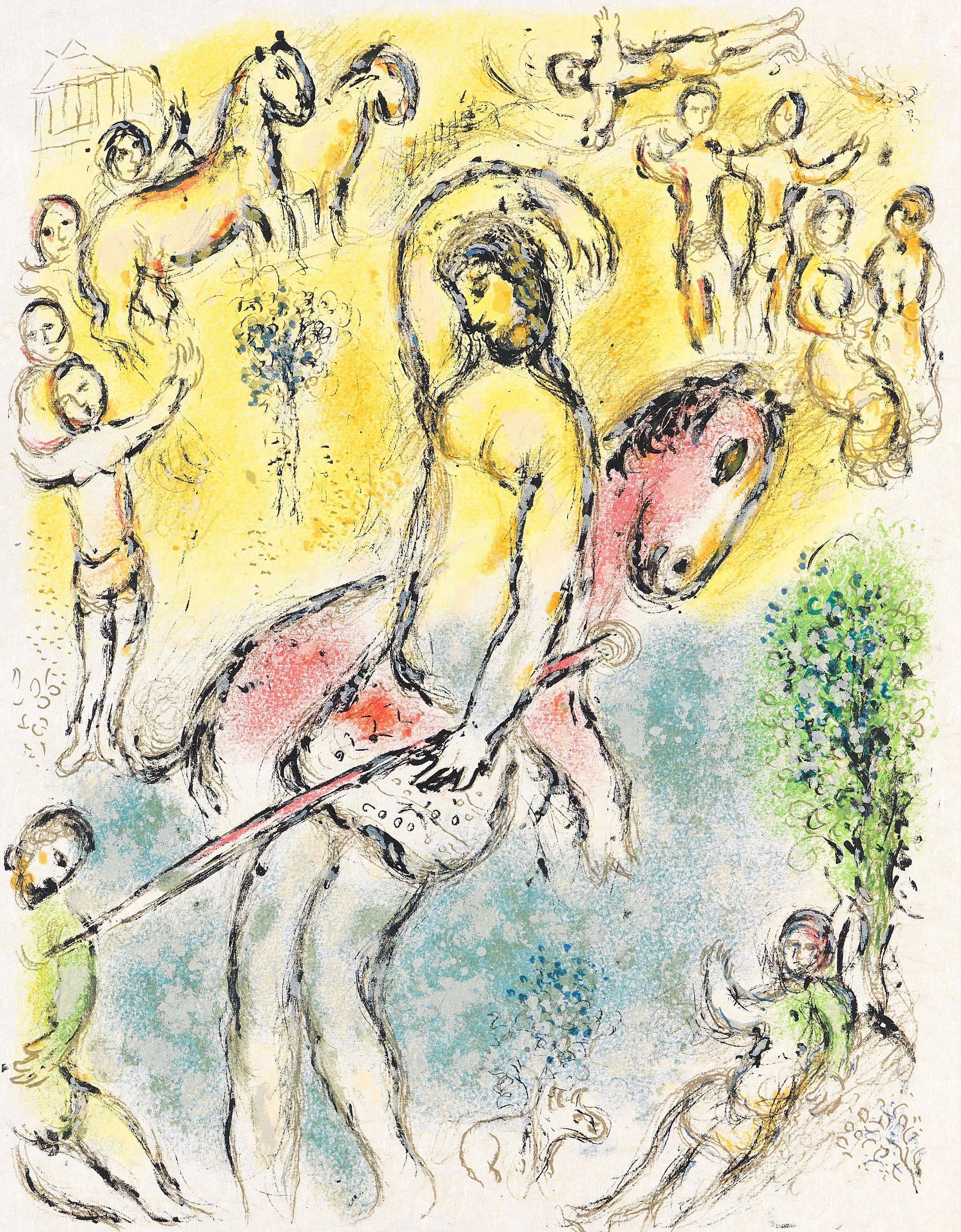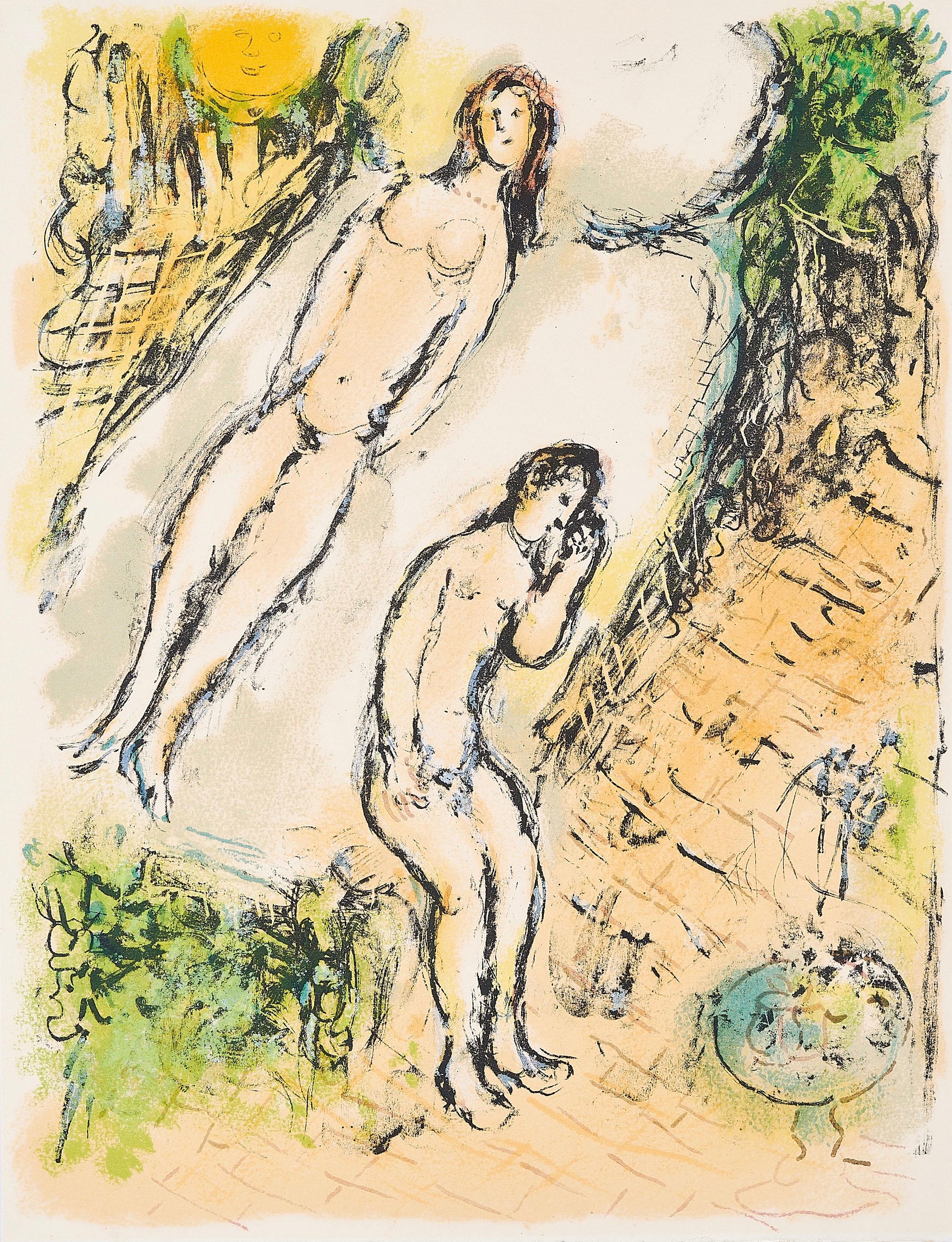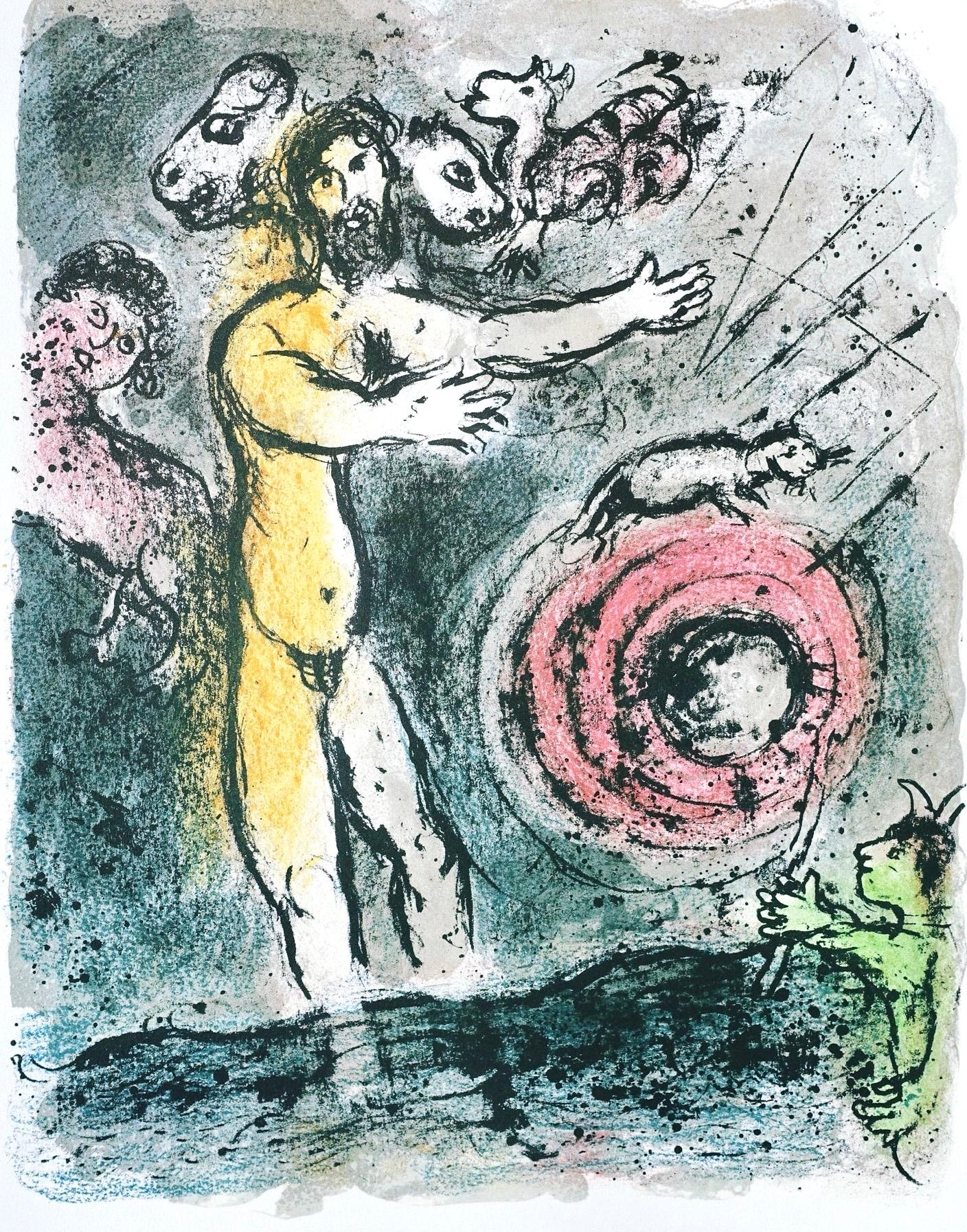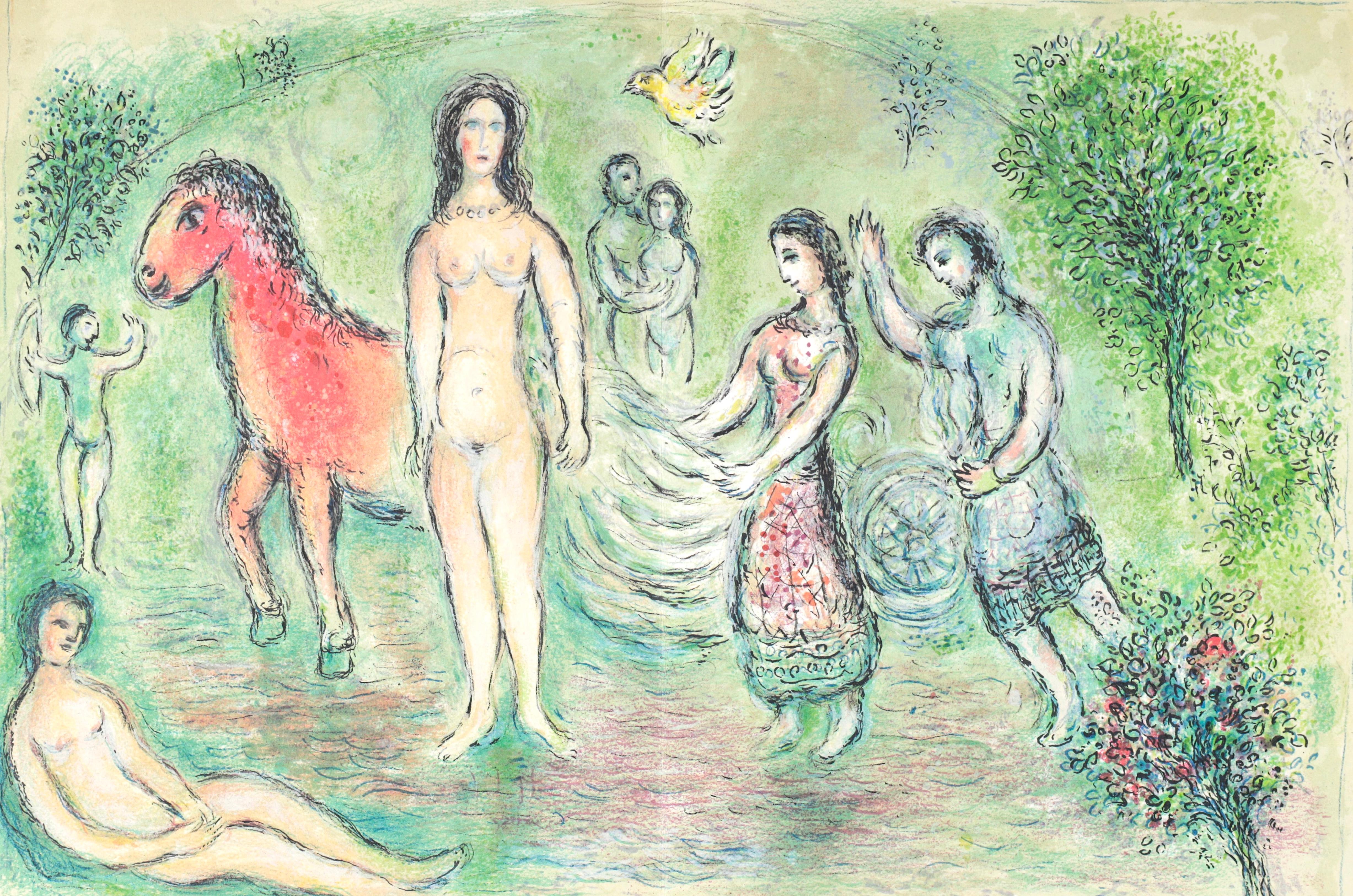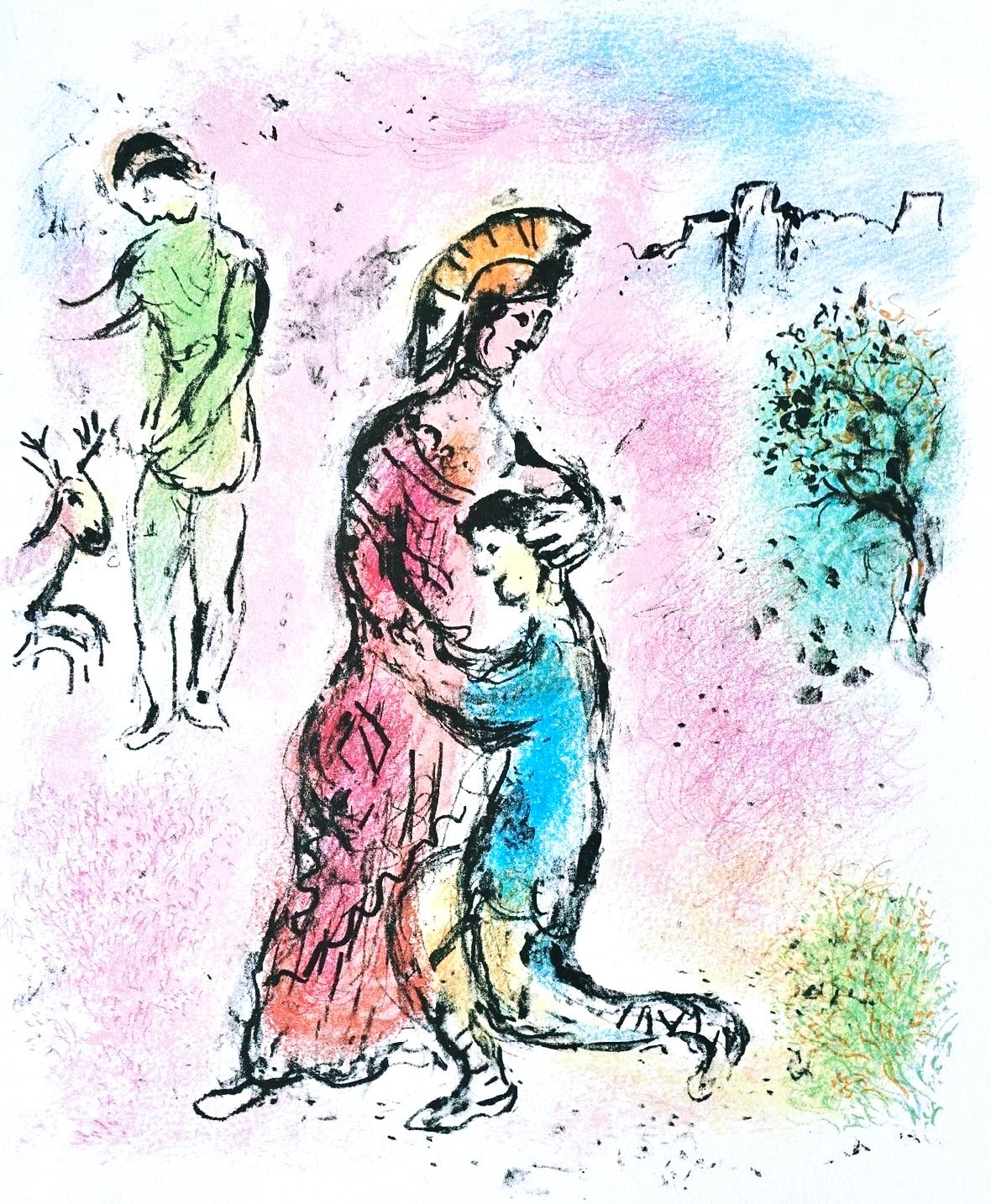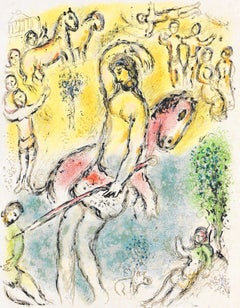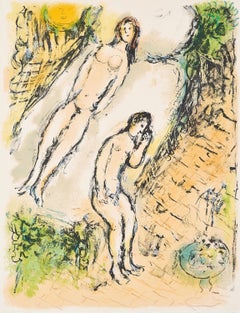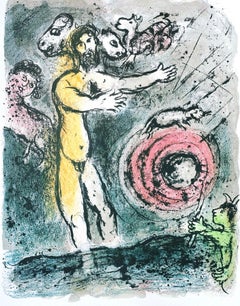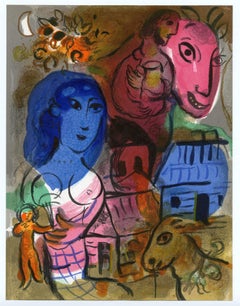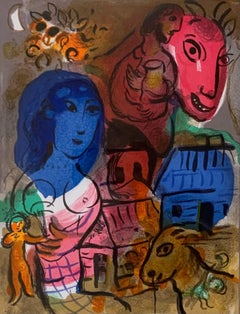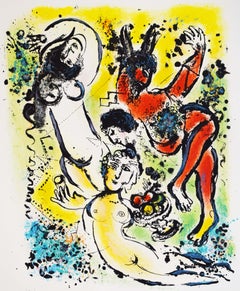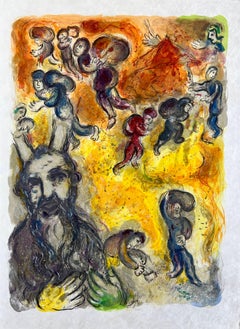Items Similar to Marc Chagall, Tityus, from Homer, The Odyssey, 1989 (after)
Want more images or videos?
Request additional images or videos from the seller
1 of 10
Marc Chagall, Tityus, from Homer, The Odyssey, 1989 (after)1989
1989
$716
$89520% Off
£559.25
£699.0720% Off
€633.98
€792.4720% Off
CA$1,026.47
CA$1,283.0820% Off
A$1,125.98
A$1,407.4720% Off
CHF 589.13
CHF 736.4120% Off
MX$13,401.37
MX$16,751.7220% Off
NOK 7,441.06
NOK 9,301.3220% Off
SEK 6,979.84
SEK 8,724.8020% Off
DKK 4,734.92
DKK 5,918.6420% Off
About the Item
This exquisite lithograph after Marc Chagall (1887–1985), titled Tityos (Tityus), from Homer, Die Odyssee (The Odyssey), originates from the 1989 German-language folio published by Daco-Verlag Gunter Blase, Stuttgart, and printed by Lichtdruck AG, Zurich, Dielsdorf, September 1989. This authorized edition, issued under the direction of Vava Chagall, presents Chagall’s powerful and haunting vision of the punishment of Tityus in the underworld. In Tityos, Chagall captures the eternal torment of the mythic giant through expressive movement and emotional color, transforming the tragic myth into a profound reflection on sin, suffering, and redemption within his timeless dreamlike aesthetic.
Executed on 250 g/m² Butten Papierwerke Miliani AG, Fabriano paper, this lithograph measures 14.88 x 11.69 inches. Unsigned and unnumbered, as issued. The edition exemplifies the exceptional quality and precision of Lichtdruck AG’s craftsmanship, reproducing the depth and richness of Chagall’s original lithographs with remarkable fidelity.
Artwork Details:
Artist: After Marc Chagall (1887–1985)
Title: Tityos (Tityus), from Homer, Die Odyssee (The Odyssey), 1989
Medium: Lithograph on 250 g/m² Butten Papierwerke Miliani AG, Fabriano paper
Dimensions: 14.88 x 11.69 inches
Inscription: Unsigned and unnumbered, as issued
Date: 1989
Publisher: Daco-Verlag Gunter Blase, Stuttgart
Printer: Lichtdruck AG, Zurich, Dielsdorf
Condition: Well preserved, consistent with age and medium
Provenance: From the folio Homer, Die Odyssee (The Odyssey), Daco-Verlag Gunter Blase, Stuttgart, 1989
Notes:
Excerpted from the folio (translated from German), Imprint—The French edition, L'Odyssée, with the original lithographs by Marc Chagall was published in 1974/75 in a CCL-example edition by Fernand Mourlot, Paris. In 1989, with the authorization of Mrs. Vava Chagall, the German-language edition of the Odyssey in two volumes was published by Daco-Verlag Gunter Blase, Stuttgart. Volume I contains the songs I - XII with XX color plates, including IV on double pages and XIX gray printed reproductions in the text. Volume II contains the songs XIII - XXIV with XXIII color plates, including II on double pages and XX gray printed reproductions in the text. For the German text, the prose translation by Wolfgang Schadewaldt was chosen with the permission of Rowohlt Taschenbuch Verlag, Reinbek near Hamburg. Set design in the Berthold Garamond Antiqua by F+M Bauer, Stuttgart. The printing production was carried out by Lichtdruck AG in Zurich/Dielsdorf. The color lithographs were reproduced in VIII - XII colors in the raster-free Granolitho process. The 210 g Butten used was specially produced by Papierwerke Miliani AG in Fabriano, Italy. The bookbinding processing was at Atelier Stemmle AG, Zurich. Responsible for the cover design: Stephan Gotz. Production and sales: Publishing manager Peter Steinbach. The circulation of the German-language edition is MMD examples, in volume II Arabic numbered by I-MMD. Some examples, designated with H.C., were designated by the publisher for his employees.
About the Publication:
The 1989 German-language edition of Homer's Die Odyssee (The Odyssey) represents a rare and beautifully executed collaboration between the literary and visual arts, authorized by Vava Chagall and produced by Daco-Verlag Gunter Blase in Stuttgart. This two-volume folio brings together Chagall’s luminous illustrations for Homer’s timeless epic, first created for the 1974/75 French edition L’Odyssée published by Fernand Mourlot. Each lithograph was rendered with meticulous attention to color and texture by Lichtdruck AG in Zurich/Dielsdorf using the raster-free Granolitho process, achieving remarkable fidelity to Chagall’s original prints. The edition was printed on fine 250 g/m² Butten paper specially made by Papierwerke Miliani AG, Fabriano, and bound by Atelier Stemmle AG in Zurich. Through its craftsmanship and literary resonance, the Odyssee folio exemplifies the posthumous continuation of Chagall’s vision under the care of Vava Chagall, uniting myth, color, and emotion in a masterful synthesis of art and storytelling.
About the Artist:
Marc Chagall (1887–1985) was a Belarus-born French painter, printmaker, and designer whose visionary imagination, radiant color, and deeply poetic symbolism made him one of the most beloved and influential artists of the 20th century. Rooted in the imagery of his Jewish heritage and the memories of his childhood in Vitebsk, Chagall’s art wove together themes of faith, love, folklore, and fantasy with a dreamlike modern sensibility. His unique style—merging elements of Cubism, Fauvism, Expressionism, and Surrealism—defied categorization, transforming ordinary scenes into lyrical meditations on memory and emotion. Influenced by Russian icon painting, medieval religious art, and the modern innovations of artists such as Pablo Picasso, Henri Matisse, and Georges Braque, Chagall developed a profoundly personal visual language filled with floating figures, vibrant animals, musicians, and lovers that symbolized the transcendent power of imagination and love. During his early years in Paris, he became an integral part of the Ecole de Paris circle, forming friendships with Amedeo Modigliani, Fernand Leger, and Sonia Delaunay, and his creative spirit resonated with that of his peers and successors—Alexander Calder, Alberto Giacometti, Salvador Dali, Joan Miro, Wassily Kandinsky, Marcel Duchamp, and Man Ray—artists who, like Chagall, sought to push the boundaries of perception, emotion, and form. Over a prolific career that spanned painting, printmaking, stained glass, ceramics, and stage design, Chagall brought an unparalleled poetic sensibility to modern art, infusing even the most abstract subjects with human warmth and spiritual depth. His works are held in the most prestigious museums around the world, including the Museum of Modern Art, the Centre Pompidou, the Tate, and the Guggenheim, where they continue to inspire generations of artists and collectors. The highest price ever paid for a Marc Chagall artwork is approximately $28.5 million USD, achieved in 2017 at Sotheby’s New York for Les Amoureux (1928).
Marc Chagall Tityos, Chagall Die Odyssee, Chagall The Odyssey, Chagall Daco-Verlag Gunter Blase, Chagall Lichtdruck AG Zurich, Chagall 1989 edition, Chagall Vava Chagall authorized, Chagall Homer Odyssey, Chagall Fabriano paper, Chagall lithograph, Chagall collectible print.
- Creation Year:1989
- Dimensions:Height: 14.88 in (37.8 cm)Width: 11.69 in (29.7 cm)
- Medium:
- Movement & Style:
- After:Marc Chagall (1887 - 1985, French)
- Period:
- Condition:
- Gallery Location:Southampton, NY
- Reference Number:1stDibs: LU1465217221142
About the Seller
4.9
Platinum Seller
Premium sellers with a 4.7+ rating and 24-hour response times
Established in 1978
1stDibs seller since 2021
1,222 sales on 1stDibs
Typical response time: <1 hour
- ShippingRetrieving quote...Shipping from: Southampton, NY
- Return Policy
More From This Seller
View AllMarc Chagall, Theoclymenus, from Homer, The Odyssey, 1989 (after)
By Marc Chagall
Located in Southampton, NY
This exquisite lithograph after Marc Chagall (1887–1985), titled Theoclymenus, from Homer, Die Odyssee (The Odyssey), originates from the 1989 German-language folio published by Daco...
Category
1980s Expressionist Figurative Prints
Materials
Lithograph
$716 Sale Price
20% Off
Marc Chagall, ...I Am Odysseus, from Homer, The Odyssey, 1989 (after)
By Marc Chagall
Located in Southampton, NY
This exquisite lithograph after Marc Chagall (1887–1985), titled ...Ich bin Odysseus (...I Am Odysseus), from Homer, Die Odyssee (The Odyssey), originates from the 1989 German-langua...
Category
1980s Expressionist Figurative Prints
Materials
Lithograph
$716 Sale Price
20% Off
Free Shipping
Marc Chagall, Lamentations of Odysseus, from Homer, The Odyssey, 1989 (after)
By Marc Chagall
Located in Southampton, NY
This exquisite lithograph after Marc Chagall (1887–1985), titled Wehklagen des Odysseus (Lamentations of Odysseus), from Homer, Die Odyssee (The Odyssey), originates from the 1989 Ge...
Category
1980s Expressionist Figurative Prints
Materials
Lithograph
$716 Sale Price
20% Off
Free Shipping
Marc Chagall, Proteus, from Homer, The Odyssey, 1989 (after)
By Marc Chagall
Located in Southampton, NY
This exquisite lithograph after Marc Chagall (1887–1985), titled Proteus (Proteus), from Homer, Die Odyssee (The Odyssey), originates from the 1989 German-language folio published by...
Category
1980s Expressionist Figurative Prints
Materials
Lithograph
$716 Sale Price
20% Off
Free Shipping
Marc Chagall, Odysseus Before Nausicaa, from Homer, The Odyssey, 1989 (after)
By Marc Chagall
Located in Southampton, NY
This exquisite lithograph after Marc Chagall (1887–1985), titled Odysseus vor Nausikaa (Odysseus Before Nausicaa), from Homer, Die Odyssee (The Odyssey), originates from the 1989 Ger...
Category
1980s Expressionist Figurative Prints
Materials
Lithograph
$796 Sale Price
20% Off
Free Shipping
Marc Chagall, Odysseus Reveals Himself, The Odyssey, 1989 (after)
By Marc Chagall
Located in Southampton, NY
This exquisite lithograph after Marc Chagall (1887–1985), titled Odysseus macht sich bekannt (Odysseus Reveals Himself), from Homer, Die Odyssee (The Odyssey), originates from the 19...
Category
1980s Expressionist Figurative Prints
Materials
Lithograph
$716 Sale Price
20% Off
Free Shipping
You May Also Like
XXe Siecle-Hommage a Marc Chagall
By Marc Chagall
Located in Fairlawn, OH
XXe Siecle-Hommage a Marc Chagall
Color lithograph, 1969
Unsigned as issued by XXe Siecle
From: XXe Siecle, Volume, Special Issue Marc Chagall
Published by G. di San Lazzaro for A. M...
Category
1960s French School Figurative Prints
Materials
Lithograph
Homage to Marc Chagall, from XXe Siecle
By Marc Chagall
Located in Washington, DC
Artist: Marc Chagall
Title: Homage to Marc Chagall
Portfolio: XXe Siecle
Medium: Lithograph
Year: 1969
Edition: Unnumbered
Framed Size: 20 1/2" x 17 1/4"
Sheet Size: 12" x 9 1/2"
Im...
Category
1960s Modern Figurative Prints
Materials
Lithograph
Take up again, muses… Theocritus, from: In the Land of the Gods - Greek Myths
By Marc Chagall
Located in London, GB
This original lithograph in colours is hand signed in pencil by the artist "Marc Chagall" at the lower right margin.
It is also numbered 19 in pencil from the edition of 75, at the l...
Category
1960s Modern Figurative Prints
Materials
Lithograph
And in those dayes, when Moses was growen... - The Exodus
By Marc Chagall
Located in OPOLE, PL
This work will be exhibited at Art on Paper NYC, September 4–7, 2025.
–-
Marc Chagall (1887-1985) - And in those dayes, when Moses was growen, he went foorth unto his brethren, and...
Category
1960s Symbolist More Prints
Materials
Lithograph
$4,230 Sale Price
20% Off
Marc Chagall - The Bible - David saved by Michal - from VERVE
By Marc Chagall
Located in Collonge Bellerive, Geneve, CH
Marc Chagall, Lithograph from Verve depicting an instant of the Bible.
Technique: Lithograph in colours (Mourlot no. 234)
On the reverse: another black and white original lithograph ...
Category
1960s Modern Figurative Prints
Materials
Lithograph
Marc Chagall - Homage to Marc Chagall - Original Lithograph
By Marc Chagall
Located in Collonge Bellerive, Geneve, CH
Marc Chagall
Original Lithograph
1969
From the revue XXe Siecle, edition of 12,000
Unsigned, as issued
Dimensions: 32 x 24
Condition : Excellent
Reference: Mourlot 572
Marc Chagall (born in 1887)
Marc Chagall was born in Belarus in 1887 and developed an early interest in art. After studying painting, in 1907 he left Russia for Paris, where he lived in an artist colony on the city’s outskirts. Fusing his own personal, dreamlike imagery with hints of the fauvism and cubism popular in France at the time, Chagall created his most lasting work—including I and the Village (1911)—some of which would be featured in the Salon des Indépendants exhibitions. After returning to Vitebsk for a visit in 1914, the outbreak of WWI trapped Chagall in Russia. He returned to France in 1923 but was forced to flee the country and Nazi persecution during WWII. Finding asylum in the U.S., Chagall became involved in set and costume design before returning to France in 1948. In his later years, he experimented with new art forms and was commissioned to produce numerous large-scale works. Chagall died in St.-Paul-de-Vence in 1985.
The Village
Marc Chagall was born in a small Hassidic community on the outskirts of Vitebsk, Belarus, on July 7, 1887. His father was a fishmonger, and his mother ran a small sundries shop in the village. As a child, Chagall attended the Jewish elementary school, where he studied Hebrew and the Bible, before later attending the Russian public school. He began to learn the fundamentals of drawing during this time, but perhaps more importantly, he absorbed the world around him, storing away the imagery and themes that would feature largely in most of his later work.
At age 19 Chagall enrolled at a private, all-Jewish art school and began his formal education in painting, studying briefly with portrait artist Yehuda Pen. However, he left the school after several months, moving to St. Petersburg in 1907 to study at the Imperial Society for the Protection of Fine Arts. The following year, he enrolled at the Svanseva School, studying with set designer Léon Bakst, whose work had been featured in Sergei Diaghilev's Ballets Russes. This early experience would prove important to Chagall’s later career as well.
Despite this formal instruction, and the widespread popularity of realism in Russia at the time, Chagall was already establishing his own personal style, which featured a more dreamlike unreality and the people, places and imagery that were close to his heart. Some examples from this period are his Window Vitebsk (1908) and My Fianceé with Black Gloves (1909), which pictured Bella Rosenfeld, to whom he had recently become engaged.
The Beehive
Despite his romance with Bella, in 1911 an allowance from Russian parliament member and art patron Maxim Binaver enabled Chagall to move to Paris, France. After settling briefly in the Montparnasse neighborhood, Chagall moved further afield to an artist colony known as La Ruche (“The Beehive”), where he began to work side by side with abstract painters such as Amedeo Modigliani and Fernand Léger as well as the avant-garde poet Guillaume Apollinaire. At their urging, and under the influence of the wildly popular fauvism and cubism, Chagall lightened his palette and pushed his style ever further from reality. I and the Village (1911) and Homage to Apollinaire (1912) are among his early Parisian works, widely considered to be his most successful and representative period.
Though his work stood stylistically apart from his cubist contemporaries, from 1912 to 1914 Chagall exhibited several paintings at the annual Salon des Indépendants exhibition, where works by the likes of Juan Gris, Marcel Duchamp and Robert Delaunay were causing a stir in the Paris art world. Chagall’s popularity began to spread beyond La Ruche, and in May 1914 he traveled to Berlin to help organize his first solo exhibition, at Der Sturm Gallery. Chagall remained in the city until the highly acclaimed show opened that June. He then returned to Vitebsk, unaware of the fateful events to come.
War, Peace and Revolution
In August 1914 the outbreak of World War I precluded Chagall’s plans to return to Paris. The conflict did little to stem the flow of his creative output, however, instead merely giving him direct access to the childhood scenes so essential to his work, as seen in paintings such as Jew in Green (1914) and Over Vitebsk (1914). His paintings from this period also occasionally featured images of the war’s impact on the region, as with Wounded Soldier (1914) and Marching (1915). But despite the hardships of life during wartime, this would also prove to be a joyful period for Chagall. In July 1915 he married Bella, and she gave birth to a daughter, Ida, the following year. Their appearance in works such as Birthday (1915), Bella and Ida by the Window (1917) and several of his “Lovers” paintings give a glimpse of the island of domestic bliss that was Chagall’s amidst the chaos.
To avoid military service and stay with his new family, Chagall took a position as a clerk in the Ministry of War Economy in St. Petersburg. While there he began work on his autobiography and also immersed himself in the local art scene, befriending novelist Boris Pasternak, among others. He also exhibited his work in the city and soon gained considerable recognition. That notoriety would prove important in the aftermath of the 1917 Russian Revolution when he was appointed as the Commissar of Fine Arts in Vitebsk. In his new post, Chagall undertook various projects in the region, including the 1919 founding of the Academy of the Arts. Despite these endeavors, differences among his colleagues eventually disillusioned Chagall. In 1920 he relinquished his position and moved his family to Moscow, the post-revolution capital of Russia.
In Moscow, Chagall was soon commissioned to create sets and costumes for various productions at the Moscow State Yiddish Theater, where he would paint a series of murals titled Introduction to the Jewish Theater as well. In 1921, Chagall also found work as a teacher at a school for war orphans. By 1922, however, Chagall found that his art had fallen out of favor, and seeking new horizons he left Russia for good.
Flight
After a brief stay in Berlin, where he unsuccessfully sought to recover the work exhibited at Der Sturm before the war, Chagall moved his family to Paris in September 1923. Shortly after their arrival, he was commissioned by art dealer and publisher Ambroise Vollard to produce a series of etchings for a new edition of Nikolai Gogol's 1842 novel Dead Souls. Two years later Chagall began work on an illustrated edition of Jean de la Fontaine’s Fables, and in 1930 he created etchings for an illustrated edition of the Old Testament, for which he traveled to Palestine to conduct research.
Chagall’s work during this period brought him new success as an artist and enabled him to travel throughout Europe in the 1930s. He also published his autobiography, My Life (1931), and in 1933 received a retrospective at the Kunsthalle in Basel, Switzerland. But at the same time that Chagall’s popularity was spreading, so, too, was the threat of Fascism and Nazism. Singled out during the cultural "cleansing" undertaken by the Nazis in Germany, Chagall’s work was ordered removed from museums throughout the country. Several pieces were subsequently burned, and others were featured in a 1937 exhibition of “degenerate art” held in Munich. Chagall’s angst regarding these troubling events and the persecution of Jews in general can be seen in his 1938 painting White Crucifixion.
With the eruption of World War II, Chagall and his family moved to the Loire region before moving farther south to Marseilles following the invasion of France. They found a more certain refuge when, in 1941, Chagall’s name was added by the director of the Museum of Modern Art (MOMA) in New York City to a list of artists and intellectuals deemed most at risk from the Nazis’ anti-Jewish campaign. Chagall and his family would be among the more than 2,000 who received visas and escaped this way.
Haunted Harbors
Arriving in New York City in June 1941, Chagall discovered that he was already a well-known artist there and, despite a language barrier, soon became a part of the exiled European artist community. The following year he was commissioned by choreographer Léonide Massine to design sets and costumes for the ballet Aleko, based on Alexander Pushkin’s “The Gypsies” and set to the music of Pyotr Ilyich Tchaikovsky.
But even as he settled into the safety of his temporary home, Chagall’s thoughts were frequently consumed by the fate befalling the Jews of Europe and the destruction of Russia, as paintings such as The Yellow Crucifixion...
Category
1960s Surrealist Figurative Prints
Materials
Lithograph

